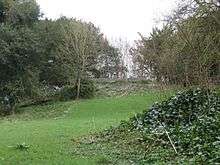Ashley Castle

The remains of Ashley Castle are in the small village of Ashley, Hampshire (grid reference SU385308).
The castle (also sometimes referred to as Gains Castle),[1] was built in 1138, on the site of a former Iron Age fort. The site is likely to have been of strategic value, standing on high ground, having a well, and lying a short distance from the Roman road from Winchester to Sarum. Its builder was the powerful Henry de Blois, who was a grandson of William I of England, the younger brother of King Stephen, Bishop of Winchester, a prolific builder (including of Wolvesey Palace in nearby Winchester) and one of the most powerful figures of his day. The castle was built during the Anarchy, a prolonged period of unrest and civil war. In 1155, following the accession of King Henry II, the castle was slighted in circumstances which are not documented.
Within fifty years, however, during the reign of Henry II's son King John, the castle was restored by William Briwere the elder. William Briwere held the manor of Ashley,[2] was a leading counsellor of King John (and later King Henry III), and would go on to found nearby Mottisfont Abbey, a house of Augustinian canons. In 1200 King John granted Briwere a licence to crenellate a castle at either Stockbridge or Ashley, and he chose Ashley (referred to in the grant as "Esleg"[3]).[4] In an age when the crown saw a potential rebel stronghold in each castle held by the nobility, permission to fortify in this way was a rare privilege. King John is documented as having stayed frequently at Ashley, probably in connection with hunting expeditions in the royal Forest of Bere - of which the nearby river Test formed the western boundary at the time.[5][2] Official crown business is known to have been transacted from the castle, as a number of royal letters from this era are headed 'Ashley'. Ashley was the administrative headquarters of West Bere, which stretched from the river Itchen to the river Test. The warden had his manor there, and would have stayed in the castle when in residence (Briwere had other estates as well). Many English forests had a castle headquarters of this sort. In addition to serving as a residence, pleas were heard, poachers sometimes imprisoned and forest officers housed at the castle. Despite its role as an administrative base for crown land, Ashley Castle appears always to have been considered as part of the manor of Ashley rather than as crown property, and the interests of the wardens were often allowed to overrule the interest of the sovereigns whose property they were supposed to be protecting. [6]
Later, until the middle of the 15th century, Ashley Castle was used as a residence by the Bishops of Winchester. It was eventually abandoned in about the 17th century.[7]
In its earliest form, the castle included a circular area enclosed by a bank and deep ditch and containing a wooden tower. Extending in a loop from the first bank was another, similar bank enclosing a court - the outer bailey - which contained domestic buildings and the parish church (which probably predates the castle). Both banks were surmounted by wooden palisades.[8]
The work is typically Norman in the small size of the occupied area and the strength of its ramparts, and in having a bailey; its north-east part contains visible remains of foundations. [1] [9] [10]
The site is a scheduled monument, protected by law.[11][12]
Notes
- 1 2 Philip Davis. "Gains Castle, Ashley". gatehouse-gazetteer.info.
- 1 2 "Parishes: Ashley". british-history.ac.uk.
- ↑ "The Gatehouse website record of a licence to crenellate for Gains Castle, Ashley granted on 1200 June 6". gatehouse-gazetteer.info.
- ↑ Cal. Rot. Chart. (Rec. Com.), i, 70.
- ↑ King John's Itin. Rot. Lit. Pat. (Rec. Com.), I
- ↑ 'The History of Ashley, Kate Gilbert, published by Hampshire County Council, 1992, ISBN 1 873595 25 5
- ↑ http://news.bbc.co.uk/dna/place-lancashire/plain/A82144370
- ↑ 'The History of Ashley, Kate Gilbert, published by Hampshire County Council, 1992, ISBN 1 873595 25 5
- ↑ "Ashley Castle". ecastles. Archived from the original on 14 December 2007. Retrieved 2007-12-02.
- ↑ Williams-Freeman (1913)
- ↑ Historic England. "Details from listed building database (1013635)". National Heritage List for England. Retrieved 27 September 2015.
- ↑ http://magic.defra.gov.uk/Metadata_for_magic/rsm/26727.pdf
See also
- Fry, Plantagenet Somerset (1980). The David & Charles Book of Castles. Newton Abbot: David & Charles. p. 180. ISBN 0-7153-7976-3.
Coordinates: 51°04′31″N 1°27′07″W / 51.07524°N 1.45183°W